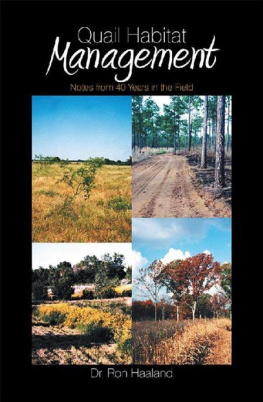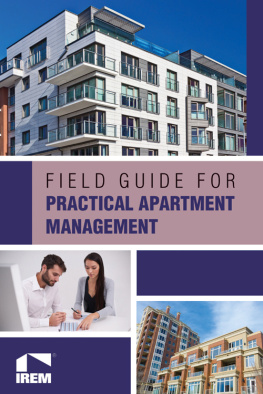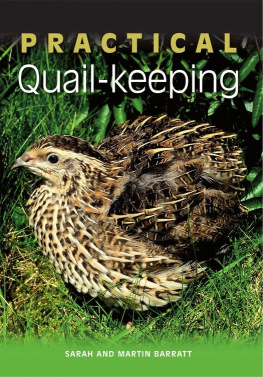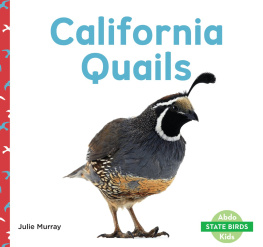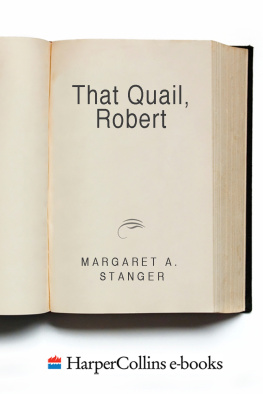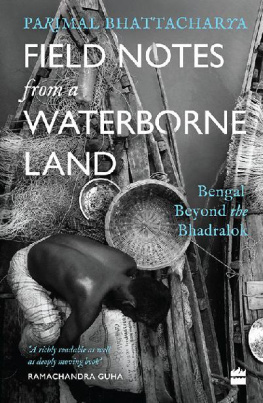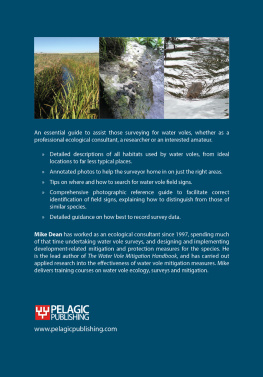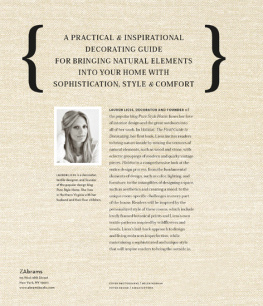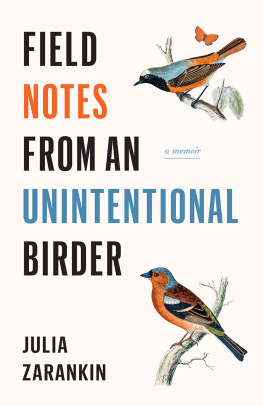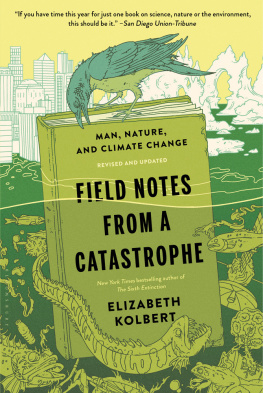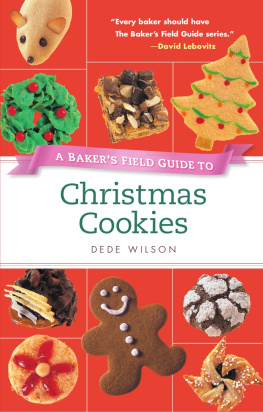Dr. Ron Haaland - Quail Habitat Management: Notes from 40 Years in the Field
Here you can read online Dr. Ron Haaland - Quail Habitat Management: Notes from 40 Years in the Field full text of the book (entire story) in english for free. Download pdf and epub, get meaning, cover and reviews about this ebook. year: 2017, publisher: Xlibris US, genre: Romance novel. Description of the work, (preface) as well as reviews are available. Best literature library LitArk.com created for fans of good reading and offers a wide selection of genres:
Romance novel
Science fiction
Adventure
Detective
Science
History
Home and family
Prose
Art
Politics
Computer
Non-fiction
Religion
Business
Children
Humor
Choose a favorite category and find really read worthwhile books. Enjoy immersion in the world of imagination, feel the emotions of the characters or learn something new for yourself, make an fascinating discovery.
- Book:Quail Habitat Management: Notes from 40 Years in the Field
- Author:
- Publisher:Xlibris US
- Genre:
- Year:2017
- Rating:4 / 5
- Favourites:Add to favourites
- Your mark:
- 80
- 1
- 2
- 3
- 4
- 5
Quail Habitat Management: Notes from 40 Years in the Field: summary, description and annotation
We offer to read an annotation, description, summary or preface (depends on what the author of the book "Quail Habitat Management: Notes from 40 Years in the Field" wrote himself). If you haven't found the necessary information about the book — write in the comments, we will try to find it.
Quail Habitat Management: Notes from 40 Years in the Field — read online for free the complete book (whole text) full work
Below is the text of the book, divided by pages. System saving the place of the last page read, allows you to conveniently read the book "Quail Habitat Management: Notes from 40 Years in the Field" online for free, without having to search again every time where you left off. Put a bookmark, and you can go to the page where you finished reading at any time.
Font size:
Interval:
Bookmark:
QUAIL HABITAT MANAGEMENT
Notes from 40 Years in the Field
Dr. Ron Haaland
Copyright 2018 by Dr. Ron Haaland.
Library of Congress Control Number: 2017918903
ISBN: Hardcover 978-1-5434-7142-7
Softcover 978-1-5434-7141-0
eBook 978-1-5434-7140-3
All rights reserved. No part of this book may be reproduced or transmitted in any form or by any means, electronic or mechanical, including photocopying, recording, or by any information storage and retrieval system, without permission in writing from the copyright owner.
Rev. date: 12/15/2017
Xlibris
1-888-795-4274
www.Xlibris.com
750701
CONTENTS
DEDICATION
To my family; Joanne, Shellie and Wade for putting up with my absence due to my continuous travels working with ag and wildlife projects in various countries.
In 1977, John Olin, chairman of Olin Corp. and owner of Winchester Firearms, invited me to come to his NILO Plantation near Albany, Georgia, to discuss developing new plants for bobwhite quail. Mr. Olin had heard about my research on special plants at Auburn University from a business associate in England. I knew Mr. Olin was a famous industrialist and sportsman; I did not know anything about NILO. I met Mr. Olin at his beautiful plantation home at NILO. He said, Dr. Haaland, there are three priorities on NILO; number one is quail, number two is quail and number three is quail and if you can agree with that we will get along fabulously. At that time, I did not know anything about bobwhite quail other than it was a beautiful game bird loved by sportsmen and birders.
I was asked to develop research on NILO to try to find plants and techniques that would be helpful in providing year around feed for quail. Fortunately, the NILO staff showed me the ropes of quail habitat and plantation management. This mentoring by Mr. Olin and his staff was an incredible experience because at that time NILO was considered the best private hunting preserve in the world hosting presidents, royalty, politicians, and many elite business people from around the world.
Work at NILO led to introduction to other fine quail plantations in Georgia, Alabama, South Carolina, and Florida. It also resulted in research with Florida Fish and Game, Tall Timbers Research, and the National Wild Turkey Federation. Expansion of activities into consultation in multiple enterprise agricultural and wildlife habitat management resulted in customers throughout the US and Mexico.
These activities were documented in notes, reports, photographs, maps, and writing habitat articles for Quail Unlimited , all of which became the basis of this book. Hopefully this book will provide ideas for your own property-management projects. Since the timeframe of this book is over forty years, you might notice things that may seem out of date or redundant, but I assure you they are based on factual observations during my work and are still relevant notes.
NOTE 1
Habitat for Quail, Man, and Dog
At last youve got a weekend to pursue your favorite bird, complete with restful sights, hushed sounds, and fragrances only fall air can provide. A chance at a bobwhite entices more people to enjoy the beauties of nature than any other game bird. You and your dog seldom have better moments. In fact, Ol Jo hits the ground with more enthusiasm than when he eats.
You start to work an area you havent worked before. Jo disappears into tall cover and you really cant tell where he is except when you see some thick grass, weeds, and bushes moving. You spend hours working through the same mess hoping you are getting close to a point.
Wirr . Birds explode three feet in front of you. With a quick shot, youve got one. But where did it fall? Wheres Jo? Stumbling through briars, vines, and plants you didnt know existed outside of Africa, you finally find your bird and your dog. Both look worse for the wear. Jos ears are bleeding; hes full of cockleburs, sandspurs, and God knows what else. Worst of all, his enthusiasm is gone. And hes not the only one who has lost his enthusiasm.
You have just spent the day in habitat that is better suited to rats and snakes than bird, man, and dog. The common denominator is the plant life. To provide a topnotch hunting experience, the plant community must be managed. This may consist of occasional disking or bush hogging, food-patch planting, and prescribed burning. There are several things to consider when you decide to manage habitat.
Habitat is a geographical area with associated plant and animal life that a bobwhite calls home, year around. The keywords are year around . Often habitat is only thought of during the hunting season. A bobwhites habitat will provide a place for the bird to eat, roost, breed, nest, brood, and start the cycle again.
Lets look at some of the key elements of habitat management. First, food must be provided year around whether by nature or with mans intervention with food patches or feeders. Often a combination of natural plants and food patches provides the greatest number of healthy birds. The food varies throughout the year due to the food source and the habits of the birds.
During winter months, seeds and vegetation are the mainstay. Youve undoubtedly heard of some of the quails favorites: partridge peas, beggarweed, ragweed, clovers, bicolor lespedeza, etc. During the breeding season, the birds protein demands are higher, and they switch to a diet that contains more insects. Young growing birds normally consume more insects than adults. Several winter-growing clovers and reseeding vetches are excellent insect producing crops during spring and summer.
Quail can have all the food in the world, but without cover, they wont last long. Cover for nesting, brooding, roosting, and escape is a necessary part of their world. Plantings of special plant species such as wild plum thickets, bicolor patches, partridge peas, corn, sorghum, and many other species can provide much of this cover. Prescribed burning can also aid in the development of plants that provide cover. However, be careful. Burning too frequently or too hot can make a habitat too clean and cover hard to find.
If cover is properly managed, it will provide excellent hunting. If you have bicolor strips or hedgerows a mile long with no breaks, your birds will become marathon runners. If cover is uniformly thick, you and your dog become discouraged. Of course, if you cant see your dog work, it takes much of the enjoyment out of the hunt. Break up your cover to have more fun with your sport.
Edge is critically important in habitat management. Areas where different types of plant communities come together, such as the edge of a timber stand that contains brush trailing off to a grass and bare ground opening, are favorite places for quail. You may have to make additional edge by clearing land or cutting strips through large cover areas.
Properly handled, prescribed burning will be helpful in maintaining good edge effect. Plant community composition can be altered by burning and disking. If plants are too dense, they can be thinned. Disking will often regenerate various annual and perennial herbaceous plants. People are often amazed to find that after burning or disking, they have plants they have never seen before. Often these are favorable plants such as partridge peas. Disking or burning scarifies long dormant seeds so they could germinate and grow.
Edge areas containing bare ground, such as along trails and roadways, provide dusting areas for quail. Dusting is the main way a quail keeps clean of external parasites. These open areas also provide a place for young to dry out from the mornings dew or after a rain. Learning to work a natural or manmade edge will be rewarding for you and your dog.
Birds need water but will often get it from dew on leaves. Depressions can be dug in the ground to supplement to birds water supply. I have seen a variety of things used for water containment: old tires, barrels cut in half, metal pans of various sizes, etc. These are more for the benefit of a hardworking dog than the bird though. In dry areas like Texas or Mexico, it is often necessary to put in a guzzler (water storage and release) mechanism for the birds.
Next pageFont size:
Interval:
Bookmark:
Similar books «Quail Habitat Management: Notes from 40 Years in the Field»
Look at similar books to Quail Habitat Management: Notes from 40 Years in the Field. We have selected literature similar in name and meaning in the hope of providing readers with more options to find new, interesting, not yet read works.
Discussion, reviews of the book Quail Habitat Management: Notes from 40 Years in the Field and just readers' own opinions. Leave your comments, write what you think about the work, its meaning or the main characters. Specify what exactly you liked and what you didn't like, and why you think so.

